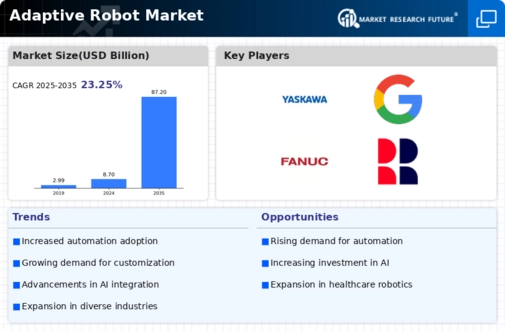Vision & Sensors
Learning, Perception, & Speech Recognition
Mobility & Navigation
On-Board
On-Cloud
Industrial Robot
Consumer Robot
Logistics Robot
Service Robot
Adaptive Robot Market By End-User Outlook (USD Billion, 2018-2032)
Automotive
Aerospace
Electronics
Food & Beverage
Healthcare
Retail
BFSI
Travel & Transportation
Education
Entertainment
Vision & Sensors
Learning, Perception, & Speech Recognition
Mobility & Navigation
On-Board
On-Cloud
Industrial Robot
Consumer Robot
Logistics Robot
Service Robot
Automotive
Aerospace
Electronics
Food & Beverage
Healthcare
Retail
BFSI
Travel & Transportation
Education
Entertainment
Vision & Sensors
Learning, Perception, & Speech Recognition
Mobility & Navigation
On-Board
On-Cloud
Industrial Robot
Consumer Robot
Logistics Robot
Service Robot
Automotive
Aerospace
Electronics
Food & Beverage
Healthcare
Retail
BFSI
Travel & Transportation
Education
Entertainment
Vision & Sensors
Learning, Perception, & Speech Recognition
Mobility & Navigation
On-Board
On-Cloud
Industrial Robot
Consumer Robot
Logistics Robot
Service Robot
Automotive
Aerospace
Electronics
Food & Beverage
Healthcare
Retail
BFSI
Travel & Transportation
Education
Entertainment
Vision & Sensors
Learning, Perception, & Speech Recognition
Mobility & Navigation
On-Board
On-Cloud
Industrial Robot
Consumer Robot
Logistics Robot
Service Robot
Automotive
Aerospace
Electronics
Food & Beverage
Healthcare
Retail
BFSI
Travel & Transportation
Education
Entertainment
Germany Outlook (USD Billion, 2018-2032)
Vision & Sensors
Learning, Perception, & Speech Recognition
Mobility & Navigation
On-Board
On-Cloud
Industrial Robot
Consumer Robot
Logistics Robot
Service Robot
Automotive
Aerospace
Electronics
Food & Beverage
Healthcare
Retail
BFSI
Travel & Transportation
Education
Entertainment
Vision & Sensors
Learning, Perception, & Speech Recognition
Mobility & Navigation
On-Board
On-Cloud
Industrial Robot
Consumer Robot
Logistics Robot
Service Robot
Automotive
Aerospace
Electronics
Food & Beverage
Healthcare
Retail
BFSI
Travel & Transportation
Education
Entertainment
Vision & Sensors
Learning, Perception, & Speech Recognition
Mobility & Navigation
On-Board
On-Cloud
Industrial Robot
Consumer Robot
Logistics Robot
Service Robot
Automotive
Aerospace
Electronics
Food & Beverage
Healthcare
Retail
BFSI
Travel & Transportation
Education
Entertainment
Vision & Sensors
Learning, Perception, & Speech Recognition
Mobility & Navigation
On-Board
On-Cloud
Industrial Robot
Consumer Robot
Logistics Robot
Service Robot
Automotive
Aerospace
Electronics
Food & Beverage
Healthcare
Retail
BFSI
Travel & Transportation
Education
Entertainment
Vision & Sensors
Learning, Perception, & Speech Recognition
Mobility & Navigation
On-Board
On-Cloud
Industrial Robot
Consumer Robot
Logistics Robot
Service Robot
Automotive
Aerospace
Electronics
Food & Beverage
Healthcare
Retail
BFSI
Travel & Transportation
Education
Entertainment
Vision & Sensors
Learning, Perception, & Speech Recognition
Mobility & Navigation
On-Board
On-Cloud
Industrial Robot
Consumer Robot
Logistics Robot
Service Robot
Automotive
Aerospace
Electronics
Food & Beverage
Healthcare
Retail
BFSI
Travel & Transportation
Education
Entertainment
Vision & Sensors
Learning, Perception, & Speech Recognition
Mobility & Navigation
On-Board
On-Cloud
Industrial Robot
Consumer Robot
Logistics Robot
Service Robot
Automotive
Aerospace
Electronics
Food & Beverage
Healthcare
Retail
BFSI
Travel & Transportation
Education
Entertainment
Vision & Sensors
Learning, Perception, & Speech Recognition
Mobility & Navigation
On-Board
On-Cloud
Industrial Robot
Consumer Robot
Logistics Robot
Service Robot
Automotive
Aerospace
Electronics
Food & Beverage
Healthcare
Retail
BFSI
Travel & Transportation
Education
Entertainment
Vision & Sensors
Learning, Perception, & Speech Recognition
Mobility & Navigation
On-Board
On-Cloud
Industrial Robot
Consumer Robot
Logistics Robot
Service Robot
Automotive
Aerospace
Electronics
Food & Beverage
Healthcare
Retail
BFSI
Travel & Transportation
Education
Entertainment
Vision & Sensors
Learning, Perception, & Speech Recognition
Mobility & Navigation
On-Board
On-Cloud
Industrial Robot
Consumer Robot
Logistics Robot
Service Robot
Automotive
Aerospace
Electronics
Food & Beverage
Healthcare
Retail
BFSI
Travel & Transportation
Education
Entertainment
Vision & Sensors
Learning, Perception, & Speech Recognition
Mobility & Navigation
On-Board
On-Cloud
Industrial Robot
Consumer Robot
Logistics Robot
Service Robot
Automotive
Aerospace
Electronics
Food & Beverage
Healthcare
Retail
BFSI
Travel & Transportation
Education
Entertainment
Vision & Sensors
Learning, Perception, & Speech Recognition
Mobility & Navigation
On-Board
On-Cloud
Industrial Robot
Consumer Robot
Logistics Robot
Service Robot
Automotive
Aerospace
Electronics
Food & Beverage
Healthcare
Retail
BFSI
Travel & Transportation
Education
Entertainment
Vision & Sensors
Learning, Perception, & Speech Recognition
Mobility & Navigation
On-Board
On-Cloud
Industrial Robot
Consumer Robot
Logistics Robot
Service Robot
Automotive
Aerospace
Electronics
Food & Beverage
Healthcare
Retail
BFSI
Travel & Transportation
Education
Entertainment
Vision & Sensors
Learning, Perception, & Speech Recognition
Mobility & Navigation
On-Board
On-Cloud
Industrial Robot
Consumer Robot
Logistics Robot
Service Robot
Automotive
Aerospace
Electronics
Food & Beverage
Healthcare
Retail
BFSI
Travel & Transportation
Education
Entertainment
Vision & Sensors
Learning, Perception, & Speech Recognition
Mobility & Navigation
On-Board
On-Cloud
Industrial Robot
Consumer Robot
Logistics Robot
Service Robot
Automotive
Aerospace
Electronics
Food & Beverage
Healthcare
Retail
BFSI
Travel & Transportation
Education
Entertainment
Vision & Sensors
Learning, Perception, & Speech Recognition
Mobility & Navigation
On-Board
On-Cloud
Industrial Robot
Consumer Robot
Logistics Robot
Service Robot
Automotive
Aerospace
Electronics
Food & Beverage
Healthcare
Retail
BFSI
Travel & Transportation
Education
Entertainment
















Leave a Comment